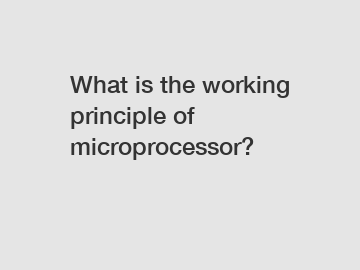What is the working principle of microprocessor?
Accubal Product Page
Welcome to the realm of microprocessors, the silent heroes powering our digital era. Have you ever wondered how these seemingly minuscule chips play a vital role in our everyday lives? In this article, we will delve into the intricate working principle of microprocessors, unlocking the secrets that make them the backbone of modern electronics.
Understanding the Basics:

A microprocessor is essentially a central processing unit (CPU) contained within a single integrated circuit. Consider it as the brain behind any electronic device, responsible for executing all the complex tasks required for smooth operation. Whether it's your smartphone, laptop, gaming console, or even your car's engine control unit, microprocessors drive it all.
Logical Segments:
Microprocessors consist of various logical segments, each designed to carry out specific functions. Starting with the Arithmetic Logic Unit (ALU), responsible for performing mathematical operations and logical comparisons, every segment has a designated role to play. The Control Unit (CU) ensures that instructions are executed in proper sequence, and the Register File stores data being operated on. Additionally, sub-units such as the Instruction Decoder, Cache, and Floating-Point Unit work in tandem to optimize performance further.
Instruction Fetch and Decode:
At its core, a microprocessor is designed to execute instructions in binary form. This means it understands and works with 0s and 1s as opposed to the human-readable codes we see in programming languages. The process begins with the Instruction Fetch stage, where the microprocessor retrieves the next instruction from memory. Subsequently, the Instruction Decoder translates the fetched instruction into a sequence of micro-operations, making it executable.
Arithmetic and Logic Operations:
The heart of a microprocessor lies in its ability to perform arithmetic and logical operations. Utilizing the ALU and Register File, the microprocessor carries out calculations, data comparisons, and manipulations as instructed by the program. Resultant values are stored in registers for further use. The ALU is capable of arithmetic operations like addition, subtraction, multiplication, and division, while logical operations include AND, OR, XOR, and NOT.
Control Flow:
One powerful aspect of microprocessors is their ability to adapt their execution flow based on the data and instructions provided. Branching and control flow instructions facilitate conditional jumps, loops, and decision-making processes. These instructions alter the sequence of execution, allowing the microprocessor to take different paths depending on the respective conditions.
Memory Access:
Every microprocessor requires fast access to data and instructions stored in memory. To optimize this process, microprocessors employ memory hierarchy which includes various levels of cache memory. Cache memory involves a set of carefully arranged memory cells where frequently used instructions and data are stored to reduce access time. Modern microprocessors use techniques like caching, prefetching, and buffering to minimize data delays and improve overall performance.
Pipelining and Superscalar Execution:
To further enhance performance, modern microprocessors utilize advanced techniques like pipelining and superscalar execution. Pipelining allows the microprocessor to execute multiple instructions simultaneously by dividing them into separate stages and overlapping their execution. Superscalar execution takes this concept further by allowing the microprocessor to issue multiple instructions simultaneously and execute them in parallel.
Conclusion:
Microprocessors, with their intricate working principles, have revolutionized the world of electronics and computing. While this article provided a glimpse into their functionalities, the realm of microprocessors is vast and ever-evolving. As technology advances, microprocessors continue to become faster, more energy-efficient, and capable of handling increasingly complex tasks. Next time you interact with any electronic device, remember the silent powerhouse silently fueling its operations – the microprocessor.
Are you interested in learning more about Weigher Supplier? Contact us today to secure an expert consultation!



